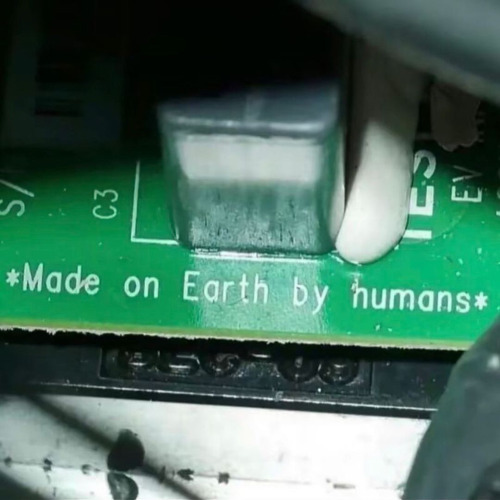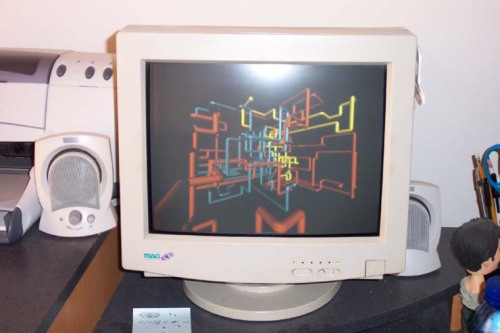꩜ Sleeper Awake: Paik’s Iconoclastic TV Bed (1972-1991) ➤

꩜ Sleeper Awake: Paik’s iconoclastic TV Bed (1972-1991) ➤
More Posts from Tomrawlingmaxisthesimsvideogame and Others

One Giant Leap for Mankind
Millions of people around the globe will come together for the Paris 2024 Olympic Games later this month to witness a grand event—the culmination of years of training and preparation.
Fifty-five years ago this July, the world was watching as a different history-changing event was unfolding: the Apollo 11 mission was landing humans on the surface of another world for the first time. An estimated 650 million people watched on TV as Neil Armstrong reached the bottom of the ladder of the lunar module on July 20, 1969, and spoke the words, “That’s one small step for [a] man, one giant leap for mankind.”
While the quest to land astronauts on the Moon was born from the space race with the Soviet Union during the Cold War, this moment was an achievement for the whole of humanity. To mark the world-embracing nature of the Moon landing, several tokens of world peace were left on the Moon during the astronauts’ moonwalk.

“We came in peace for all mankind”
These words, as well as drawings of Earth’s western and eastern hemispheres, are etched on a metal plaque affixed to a leg of the Apollo 11 lunar lander. Because the base of the lander remained on the Moon after the astronauts returned, it is still there today as a permanent memorial of the historic landing.

Microscopic messages from kings, queens, and presidents
Another artifact left on the Moon by the Apollo 11 astronauts is a small silicon disc etched with goodwill messages from leaders of 74 countries around the world. Each message was reduced to be smaller than the head of a pin and micro-etched on a disc roughly 1.5 inches (3.8 cm) in diameter. Thailand’s message, translated into English, reads: "The Thai people rejoice in and support this historic achievement of Earth men, as a step towards Universal peace."
Curious to read what else was inscribed on the disk? Read the messages.

An ancient symbol
The olive branch, a symbol of peace and conciliation in ancient Greek mythology, also found its way to the Moon in July 1969. This small olive branch made of gold was left on the lunar surface during Neil Armstrong and Buzz Aldrin’s 2.5-hour moonwalk. The olive branch also featured on the Apollo 11 mission patches sewed on the crew’s spacesuits. Designed in part by command module pilot Michael Collins, the insignia shows a bald eagle landing on the Moon holding an olive branch in its talons.

We go together
As NASA’s Artemis program prepares to again land astronauts on the Moon, including the first woman and the first person of color, this time we’re collaborating with commercial and international partners. Together we will make new scientific discoveries, establish the first long-term presence on the Moon, and inspire a new generation of explorers.
Is aerospace history your cup of tea? Be sure to check out more from NASA’s past at www.nasa.gov/history.
Make sure to follow us on Tumblr for your regular dose of space!

Okay, so: there's a local restaurant whose online ordering process involves various selecting various sauces to be included with one's order – so many units of teriyaki sauce, so many units of hot sauce, so may units of peanut sauce, and so forth.
The idea is supposed to be that you can select any combination of sauces you want, as long as it adds up to no more than four units. However, what the app actually required is that you select exactly four units of sauces; it wouldn't let you submit the ordering form if the total wasn't exactly four.
Just today I discovered that they seem to have fixed it... not by correcting the errant validation rule, but by adding a "no sauce" option, which counts toward the required total of four.
Thus, it's now possible to place an order with, say, two units of teriyaki sauce rather than four by entering 2x "teriyaki sauce" and 2x "no sauce". Similarly, an order with no sauce at all is 4x "no sauce".
This is quite possibly the least intuitive ordering process I've ever encountered, and I've literally worked in e-commerce.



🎧Today's Miku figure is:🎧
Bilibili bluetooth earbuds ver.









80s advertising radios
Source: Flickr/Joe Haupt










🖥 - computer plushies!!






hidden messages in electronic boards

What We Learned from Flying a Helicopter on Mars

The Ingenuity Mars Helicopter made history – not only as the first aircraft to perform powered, controlled flight on another world – but also for exceeding expectations, pushing the limits, and setting the stage for future NASA aerial exploration of other worlds.
Built as a technology demonstration designed to perform up to five experimental test flights over 30 days, Ingenuity performed flight operations from the Martian surface for almost three years. The helicopter ended its mission on Jan. 25, 2024, after sustaining damage to its rotor blades during its 72nd flight.
So, what did we learn from this small but mighty helicopter?
We can fly rotorcraft in the thin atmosphere of other planets.
Ingenuity proved that powered, controlled flight is possible on other worlds when it took to the Martian skies for the first time on April 19, 2021.
Flying on planets like Mars is no easy feat: The Red Planet has a significantly lower gravity – one-third that of Earth’s – and an extremely thin atmosphere, with only 1% the pressure at the surface compared to our planet. This means there are relatively few air molecules with which Ingenuity’s two 4-foot-wide (1.2-meter-wide) rotor blades can interact to achieve flight.
Ingenuity performed several flights dedicated to understanding key aerodynamic effects and how they interact with the structure and control system of the helicopter, providing us with a treasure-trove of data on how aircraft fly in the Martian atmosphere.
Now, we can use this knowledge to directly improve performance and reduce risk on future planetary aerial vehicles.

Creative solutions and “ingenuity” kept the helicopter flying longer than expected.
Over an extended mission that lasted for almost 1,000 Martian days (more than 33 times longer than originally planned), Ingenuity was upgraded with the ability to autonomously choose landing sites in treacherous terrain, dealt with a dead sensor, dusted itself off after dust storms, operated from 48 different airfields, performed three emergency landings, and survived a frigid Martian winter.
Fun fact: To keep costs low, the helicopter contained many off-the-shelf-commercial parts from the smartphone industry - parts that had never been tested in deep space. Those parts also surpassed expectations, proving durable throughout Ingenuity’s extended mission, and can inform future budget-conscious hardware solutions.

There is value in adding an aerial dimension to interplanetary surface missions.
Ingenuity traveled to Mars on the belly of the Perseverance rover, which served as the communications relay for Ingenuity and, therefore, was its constant companion. The helicopter also proved itself a helpful scout to the rover.
After its initial five flights in 2021, Ingenuity transitioned to an “operations demonstration,” serving as Perseverance’s eyes in the sky as it scouted science targets, potential rover routes, and inaccessible features, while also capturing stereo images for digital elevation maps.
Airborne assets like Ingenuity unlock a new dimension of exploration on Mars that we did not yet have – providing more pixels per meter of resolution for imaging than an orbiter and exploring locations a rover cannot reach.

Tech demos can pay off big time.
Ingenuity was flown as a technology demonstration payload on the Mars 2020 mission, and was a high risk, high reward, low-cost endeavor that paid off big. The data collected by the helicopter will be analyzed for years to come and will benefit future Mars and other planetary missions.
Just as the Sojourner rover led to the MER-class (Spirit and Opportunity) rovers, and the MSL-class (Curiosity and Perseverance) rovers, the team believes Ingenuity’s success will lead to future fleets of aircraft at Mars.
In general, NASA’s Technology Demonstration Missions test and advance new technologies, and then transition those capabilities to NASA missions, industry, and other government agencies. Chosen technologies are thoroughly ground- and flight-tested in relevant operating environments — reducing risks to future flight missions, gaining operational heritage and continuing NASA’s long history as a technological leader.
You can fall in love with robots on another planet.
Following in the tracks of beloved Martian rovers, the Ingenuity Mars Helicopter built up a worldwide fanbase. The Ingenuity team and public awaited every single flight with anticipation, awe, humor, and hope.
Check out #ThanksIngenuity on social media to see what’s been said about the helicopter’s accomplishments.
Learn more about Ingenuity’s accomplishments here. And make sure to follow us on Tumblr for your regular dose of space!



A gutted iPod turned into a cigarette case
-
 ayumoandlongani reblogged this · 1 week ago
ayumoandlongani reblogged this · 1 week ago -
 transistor-rhythm-909 reblogged this · 1 week ago
transistor-rhythm-909 reblogged this · 1 week ago -
 goosefeathered reblogged this · 1 week ago
goosefeathered reblogged this · 1 week ago -
 ana-isnt-dead liked this · 1 week ago
ana-isnt-dead liked this · 1 week ago -
 wonderwanda liked this · 1 week ago
wonderwanda liked this · 1 week ago -
 gayworths reblogged this · 1 week ago
gayworths reblogged this · 1 week ago -
 tapirtrash liked this · 1 week ago
tapirtrash liked this · 1 week ago -
 finalgirl-000 reblogged this · 1 week ago
finalgirl-000 reblogged this · 1 week ago -
 gondar6505 liked this · 1 week ago
gondar6505 liked this · 1 week ago -
 gondar6505 reblogged this · 1 week ago
gondar6505 reblogged this · 1 week ago -
 minuano reblogged this · 1 week ago
minuano reblogged this · 1 week ago -
 deeplytroubledchild liked this · 1 week ago
deeplytroubledchild liked this · 1 week ago -
 censored-archive liked this · 1 week ago
censored-archive liked this · 1 week ago -
 subtlesolitude-tailoredtaste reblogged this · 1 week ago
subtlesolitude-tailoredtaste reblogged this · 1 week ago -
 leobu liked this · 1 week ago
leobu liked this · 1 week ago -
 uozi reblogged this · 1 week ago
uozi reblogged this · 1 week ago -
 ppppronoiaaaa reblogged this · 1 week ago
ppppronoiaaaa reblogged this · 1 week ago -
 ppppronoiaaaa liked this · 1 week ago
ppppronoiaaaa liked this · 1 week ago -
 angelvalleyxp reblogged this · 1 week ago
angelvalleyxp reblogged this · 1 week ago -
 unasomiadora liked this · 1 week ago
unasomiadora liked this · 1 week ago -
 dicomely reblogged this · 1 week ago
dicomely reblogged this · 1 week ago -
 setraselausiv reblogged this · 1 week ago
setraselausiv reblogged this · 1 week ago -
 kadunud reblogged this · 1 week ago
kadunud reblogged this · 1 week ago -
 painfuldischarge liked this · 1 week ago
painfuldischarge liked this · 1 week ago -
 tangerinetinted-lenses reblogged this · 1 week ago
tangerinetinted-lenses reblogged this · 1 week ago -
 luvtranscends liked this · 1 week ago
luvtranscends liked this · 1 week ago -
 mystical-creature3 liked this · 1 week ago
mystical-creature3 liked this · 1 week ago -
 francescofouche liked this · 1 week ago
francescofouche liked this · 1 week ago -
 scottiewider liked this · 2 weeks ago
scottiewider liked this · 2 weeks ago -
 forgot-my-line liked this · 2 weeks ago
forgot-my-line liked this · 2 weeks ago -
 gayworths liked this · 2 weeks ago
gayworths liked this · 2 weeks ago -
 james-lopez-182 reblogged this · 2 weeks ago
james-lopez-182 reblogged this · 2 weeks ago -
 imchillin liked this · 2 weeks ago
imchillin liked this · 2 weeks ago -
 got2rambleon4 liked this · 2 weeks ago
got2rambleon4 liked this · 2 weeks ago -
 badmonkeysclub reblogged this · 2 weeks ago
badmonkeysclub reblogged this · 2 weeks ago -
 nearlyb liked this · 2 weeks ago
nearlyb liked this · 2 weeks ago -
 falconarr0w reblogged this · 2 weeks ago
falconarr0w reblogged this · 2 weeks ago -
 falconarr0w liked this · 2 weeks ago
falconarr0w liked this · 2 weeks ago -
 miniaturebasementnightmare liked this · 2 weeks ago
miniaturebasementnightmare liked this · 2 weeks ago -
 mulderthefox14 liked this · 2 weeks ago
mulderthefox14 liked this · 2 weeks ago -
 korenslover liked this · 2 weeks ago
korenslover liked this · 2 weeks ago -
 building-oneself reblogged this · 2 weeks ago
building-oneself reblogged this · 2 weeks ago -
 building-oneself liked this · 2 weeks ago
building-oneself liked this · 2 weeks ago -
 rebounds-and-reblogs liked this · 2 weeks ago
rebounds-and-reblogs liked this · 2 weeks ago -
 unovni reblogged this · 2 weeks ago
unovni reblogged this · 2 weeks ago -
 deardoveswings liked this · 2 weeks ago
deardoveswings liked this · 2 weeks ago -
 honeybunnygt liked this · 2 weeks ago
honeybunnygt liked this · 2 weeks ago -
 anagramtransitory liked this · 2 weeks ago
anagramtransitory liked this · 2 weeks ago -
 jimboeth liked this · 2 weeks ago
jimboeth liked this · 2 weeks ago -
 kvl00 liked this · 2 weeks ago
kvl00 liked this · 2 weeks ago
96 posts